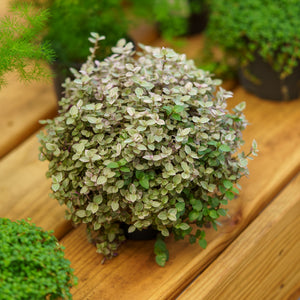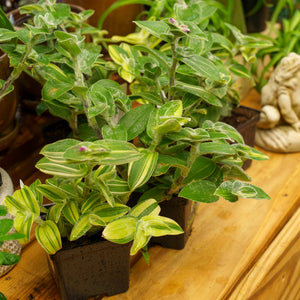The Tradescantia Guide
Tradescantia, commonly referred to as spiderwort, inch plant, or wandering jew, is a low-maintenance houseplant or hardy perennial known for its trailing habit, colorful foliage, and resilience. Its cascading stems and vibrant leaves make it an excellent choice for hanging baskets, tabletops, or groundcover in frost-free regions. Tradescantia comes in a wide range of varieties—from soft pastels to bold purples and greens—adding texture and color to any plant collection.
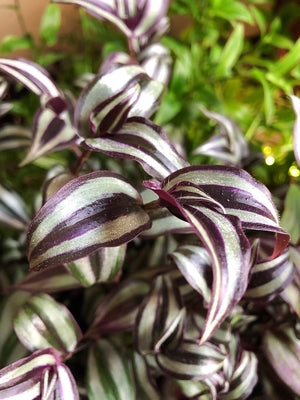
About
Native to the Americas, Tradescantia belongs to the Commelinaceae family and includes both tropical houseplants and hardy perennials. Foliage varies from solid green to striped pink, purple, silver, or cream, depending on the cultivar. Many types also produce small, three-petaled flowers in shades of purple, white, or pink.
Popular types include:
- Tradescantia albiflora 'Nanouk', with thick stems and pastel pink-striped leaves.
- Tradescantia sillamontana, prized for its fuzzy, silvery leaves and drought tolerance.
- Tradescantia spathacea (Moses-in-the-Cradle), with upright green-and-purple foliage.
- Tradescantia pallida (Purple Heart), which features deep purple leaves and bright pink flowers.
- Tradescantia 'Sweet Kate' and 'Zwanenburg Blue', which are commonly used as hardy perennials with grasslike foliage and bright blue flowers.
Their easy growth and adaptability make tradescantia a favorite for indoor and outdoor displays alike.

PLANTING
Whether grown as a houseplant or in the garden, tradescantia is easy to plant and establish:
- USDA Hardiness Zones: Most are hardy in Zones 9–11. In colder zones, they’re treated as annuals or houseplants.
- Soil: Use a well-draining potting mix for houseplants or loamy, moderately rich soil in garden beds.
- Sunlight: Indoors, bright, indirect light keeps foliage vibrant. Outdoors, morning sun and afternoon shade is ideal.
- Container Selection: Ensure pots have drainage holes. Hanging baskets, shallow pots, or troughs work well.
- Humidity: Tolerates average household humidity but thrives with extra moisture, especially in dry climates.
Transplant or repot as needed when roots become crowded, typically every 1–2 years.
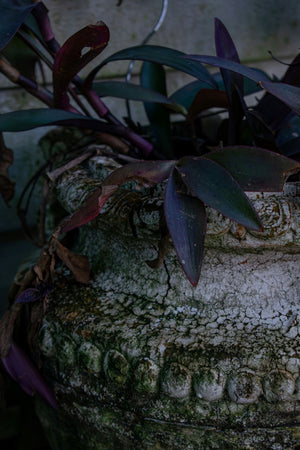
CARE
Tradescantia is known for its fast growth and forgiving nature, making it easy to maintain:
- Watering: Water when the top inch of soil feels dry. Avoid letting the soil become soggy, especially in winter.
- Fertilizing: Feed monthly with a balanced liquid fertilizer during the growing season (spring to early fall).
- Pruning: Pinch back stems to promote bushier growth and prevent legginess. Trim dead or faded leaves regularly.
- Pests: Watch for spider mites or aphids, especially in dry indoor environments. Treat with insecticidal soap if needed.
- Propagation: Easily propagated by stem cuttings. Snip below a leaf node and root in water or moist soil.
Rotate pots regularly for even light exposure and trim regularly to keep plants compact and colorful.

HOW TO USE
Tradescantia’s colorful, trailing foliage makes it a standout in many different design applications:
- Hanging Baskets: Let 'Nanouk', 'Feeling Flirty', or Callisia Rosato spill over for a bold display.
- Tabletop Containers: Use compact varieties like 'Pistachio White' in decorative pots for shelves or desks.
- Groundcover: In frost-free zones, varieties like Tradescantia pallida or sillamontana make effective groundcovers.
- Mixed Planters: Combine with ferns, caladiums, or begonias for a tropical look with varied textures.
- Terrariums & Dish Gardens: Small-stemmed types are suitable for enclosed environments with bright light and high humidity.
Tradescantia pairs well with pothos, philodendron, calathea, and succulents, creating vivid and layered foliage arrangements indoors.
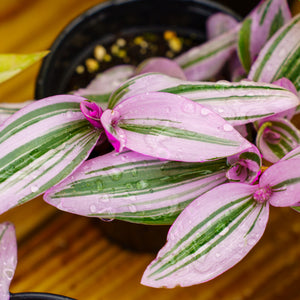
COMMON QUESTIONS
- How to propagate tradescantia? Simply cut a healthy stem just below a node, remove the lower leaves, and root it in water or moist soil. Roots usually appear within a week.
- Is tradescantia toxic to cats? Yes, tradescantia can cause skin irritation and mild digestive upset in cats.
- Is tradescantia toxic to dogs? Yes, ingestion may lead to mild gastrointestinal discomfort or drooling in dogs.
- How to care for tradescantia? Provide bright indirect light, water when the topsoil dries, and trim regularly to encourage bushiness.
- How often to water tradescantia? Water when the top inch of soil is dry. Overwatering leads to root rot, while underwatering may cause leaf curling.
- Is tradescantia a succulent? While tradescantia stores moisture in its stems and leaves, it is not a true succulent. However, some types like sillamontana are more drought-tolerant than others.
Conclusion
Tradescantia is one of the most flexible and colorful foliage plants for indoor and outdoor gardens alike. With options for hanging baskets, terrariums, or garden borders, and a reputation for fast growth and easy propagation, it’s an ideal plant for gardeners of all experience levels. With proper care and regular pruning, tradescantia will reward you with a cascade of vibrant leaves that brighten any space.
The Tradescantia Collection
Sold Out
Sold Out
Sold Out
Sold Out
Sold Out

